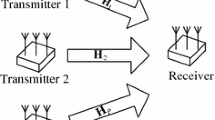Abstract
In this paper we propose a novel semiblind scheme based on second and fourth order statistics of Space–Time data in time varying MIMO channels. This scheme combines a new blind estimator of frequency offsets and an iterative decoder. Space–Time Codes have a periodic property which is used to find a simple and efficient blind estimator of carrier offsets. The iterative decoder is a data aided decoder which provides the best estimates of channel, noise co-variance and S–T data in its category. As a result of this the new semiblind scheme performs very efficiently in time-selective channels and is able to reduce the training overhead required by the data-aided estimators to a large extent, and increase the effective throughput.
Similar content being viewed by others
References
Tarokh V., Seshadri N., Calderbank A. (1998). Space–time codes for high data rate wireless communication: Performance criterion and code construction. IEEE Transactions on Information Theory 44, 744–765
Tarokh V., Jafarkhani H., Calderbank A.R. (1998). Space–time codes for wireless communication: Performance results. IEEE Journal on Selected Areas in Communications 17(3): 451–460
Seeger, R., Brotje, L., & Kammeyer, K. D. (2004). Investigation of orthogonal space–time block codes using a mimo hardware demonstrator. Department of Communications Engineering, University of Bermen.
Liu Z., Giannakis G.B., Hughes B.L. (2001). Double differential space time block coding for time selective channels. IEEE Transactions on Communications 49(9): 1529–1538
Proaskis, J. G. (1995). Digital communication (3rd ed.). McGraw Hill.
Besson O., Stoica P. (2003). On parameter estimation of MIMO flat-fading channels with frequency offsets. IEEE Transactions on Signal Processing 51(3): 602–613
Larsson, E. G., & Stoica, P. (2003). Space–time block coding for wireless communications (1st ed.). Cambridge University Press.
Hurd H.L. (1989). Nonparametric time series analysis for periodically correlated processes. IEEE Transactions on Information Theory 35(2): 350–359
Dandawate A.V., Giannakis G.B. (1994). Nonparametric polyspectral estimators for kth-order (almost) cyclostationary processes. IEEE Transactions on Information Theory 40(1): 67–84
Zhou G., Ginnakis G.B. (1995). Harmonics in multiplicative and additive noise: Performance analysis of cyclic estimators. IEEE Transactions on Signal Processing 43(6): 1445–1460
Tsatsanis M.K., Giannakis G.B. (1997). Transmitter induced cyclostationarity for blind channel equalization. IEEE Transactions on Signal Processing 45(7): 1785–1794
Alamouti S. (1998). A simple transmit diversity technique for wireless communications. IEEE Journal on Selected Areas in Communications 16, 1451–1458
Swindlehurst A., Leus G. (2002). Blind and semi-blind equalization for generalized space–time block codes. IEEE Transactions on Signal Processing 50(10): 2489–2498
Triantafyllopoulos, K. (2002). Moments and cumulants of the multivariate real and complex Gaussian distributions. Department of Mathematics, University of Bristol, Version: 12 March 2002.
Author information
Authors and Affiliations
Corresponding author
Rights and permissions
About this article
Cite this article
Bhatnagar, M.R., Vishwanath, R. A New Semiblind Scheme Based on Second and Fourth Order Statistics for Decoding of Space–Time Data in Time Selective MIMO Channels. Wireless Pers Commun 47, 193–205 (2008). https://doi.org/10.1007/s11277-008-9454-9
Received:
Accepted:
Published:
Issue Date:
DOI: https://doi.org/10.1007/s11277-008-9454-9




